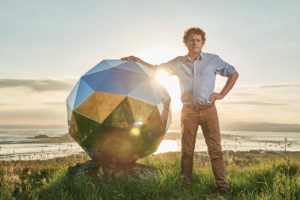
Scientist and engineer Peter Beck is on a mission to make commercial space travel a reality. He founded Rocket Lab in 2006 to provide frequent launch opportunities to low earth orbit. Beck also wanted to create a way to connect people to the night sky, to bring people together. He hopes to demonstrate that
we are all one species on a small planet, and must work together to solve earthbound challenges like climate change and resource shortages.
Rocket Lab launched the Humanity Star from its New Zealand launch site in January 2018; it orbits Earth every 90 minutes and is visible to the naked eye in the night sky. The satellite is a geodesic sphere made from carbon fiber and 65 highly reflective panels. It spins rapidly, briefly reflecting the sun’s light back to Earth to create a fleeting moment of light.
The Humanity Star measures only 3.2 feet and weighs about 17.6 pounds. Because it’s made of triangles, the sphere is particularly strong, as all forces are shared throughout the entire structure. People can track the sphere’s location on the Humanity Star’s website and determine when it will be accessible for viewing in their locations. It is most visible at dawn and dusk; as it passes, the “star” may be visible for up to a few minutes.
The Humanity Star will remain in space for about nine months before the orbit begins to degrade and it burns completely as it enters Earth’s atmosphere. For more information, visit www.thehumanitystar.com.
 TEXTILES.ORG
TEXTILES.ORG



